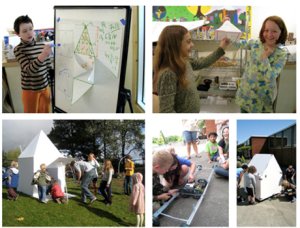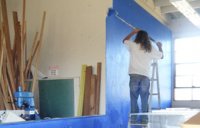Engaging Students in the STEM Classroom Through “Making”
A few days ago, I visited a math teacher who was busily preparing his classroom for the start of the school year. This classroom, however, was a bit unusual. Casey Shea, who teaches at Analy High School in Sebastopol, California, was transforming an old wood shop into a "makerspace." With his students’ help, much of the furniture was built from scratch, and the space will soon be filled with students working on projects that might range from solar-powered battery chargers to geodesic domes and a pedal-powered blender.
Casey is one of a growing number of teachers who are incorporating "making" into their teaching methods, and turning their classrooms into makerspaces.
What is making?
The past few years have seen increased interest in making and makers. A maker is someone who makes something -- from food to robots, wooden furniture to microcontroller-driven art installations. Makers are typically driven by their curiosity for learning and creating new things, as well as by an interest in sharing their work and processes with others.
Maker Faires are now occurring in cities throughout the world. These gatherings allow makers to exhibit their work, and to gain inspiration, new ideas, and new friends. Online communities where people share their projects and how-to guides are flourishing. There is a sense of play in the maker community. If you wander around a Maker Faire, many of the things you will see are incredibly complex, but also have an element of whimsy to them. More and more families and children are attending these Faires and wondering how they can get started in making.
How does making relate to STEM education?
For the six years prior to joining the Maker Education Initiative, I was an engineering professor teaching engineering to undergraduate students and PK-12 educators. One of the things that struck me in discussions with other engineering professors around the country was how many students had little experience in actually building things. Making is about realizing that you can be a creator instead of just a consumer. At its best, making allows kids to follow their own interests and passions and create something that is uniquely theirs, while applying the knowledge that they are gathering in all aspects of their life.
At a time when many people are asking how we can get more students interested in STEM fields, we are hearing from teachers who have found making to be a great way to get students excited and engaged in their classrooms. We are seeing making occurring in subject classes such as math or science -- in classes specifically listed as maker classes -- and in a variety of less formal settings such as clubs and study halls. Many of these projects incorporate a variety of STEM topics. Students working on designing and building furniture for their classroom use algebra and geometry to figure out the dimensions. E-textiles and soft circuitry, in which circuits are sewn using conductive thread or fabric, have shown to be an engaging way to teach electronics and programming, especially for young women. The possibilities for ways to incorporate making into the school day are endless, and it is exciting to see what teachers have been developing and sharing.

One of my colleagues at the Maker Education Initiative, Steve Davee, spent 8 years teaching math and science at the Opal School. Steve is a maker at heart, and is always looking for ways to get his students involved. Not long after Hurricane Katrina, Steve was having a conversation with his fifth grade math class about emergency shelters. Steve realized that his students were truly interested in finding ways to help people impacted by such disasters, and that such a project could incorporate many of the academic standards that he would have to cover in that class, such as volume, fractions, measurements and averages.
His students started creating designs for these shelters in their notebooks and building scale models. The students then wanted to create a full scale model, but didn’t have access to enough materials for an adult shelter, so they decided to build an emergency shelter for preschoolers. After measuring preschoolers, the students went on to collaboratively build a full-scale preschooler emergency shelter, which was quite popular with students and teachers of all sizes! A fourth grader at the school saw this project, and decided that it would be great if the shelter could drive itself to emergencies. In his free time, at school and at home, this student built a prototype of a shelter on a robotic base that could drive itself. When I talked to Steve about this project he stressed that one of the key elements was that it came out of his students truly caring about providing a solution to a problem that they felt was important.
Making is about empowering students to see that they can bring their ideas to life, and create new things. I strongly believe that we are all makers at heart, and that every new project incorporates new learning opportunities. So, I’ll end with a question: what will you make this school year?
Where to find making activities for your classroom
Many makers are willing to share their projects and help others. This has led to a wealth of online resources and project instructions. Some good places to look for project inspiration and instructions include:
- Make: Projects is a curated site with a strong emphasis on maker projects, and the Kids and Family section of the Make: blog has projects specifically aimed at young makers.
- Instructables has 80,000+ illustrated projects ranging from food to electronics.
- Adafruit has tutorials that cover topics such as electronics and Arduino microcontrollers.
- The High Tech Low Tech group at MIT’s Media Lab has created a workshop facilitator’s guide for soft circuits.
What other ways can I get involved in making?
- Go to a Maker Faire or a Mini-Maker Faire! Maker Faires are gathering where makers share their work. It’s a fantastic place to get inspiration for projects to do with your students.
- Look to see if your city has a hackerspace or makerspace. This is often a good place to find the makers in your city. (Here is a list of hackerspaces)
